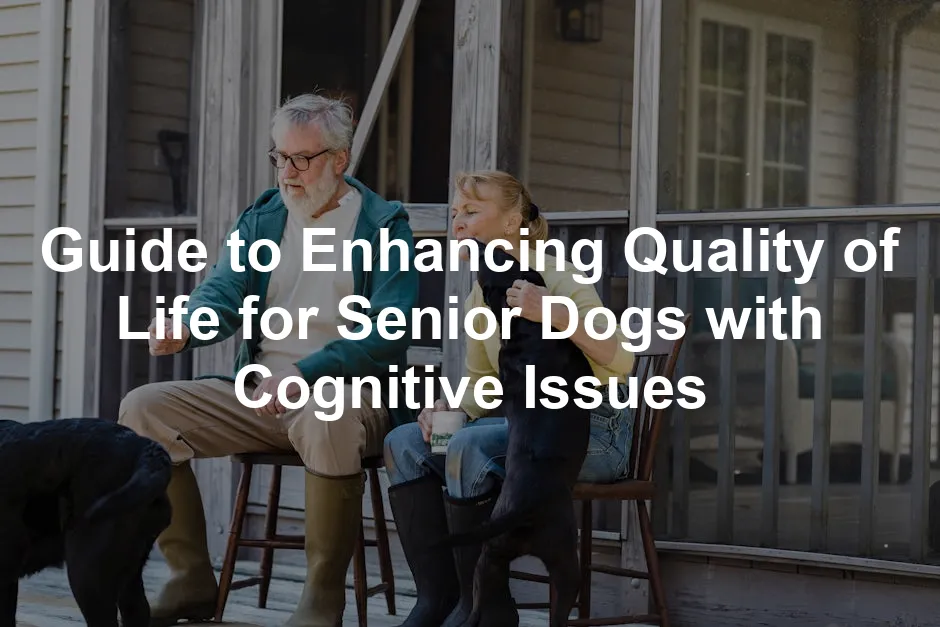Introduction
The golden years of our furry companions can sometimes feel like a puzzling maze. Cognitive issues can sneak in like a thief in the night, stealing away the joy from our beloved pets. Just like humans, senior dogs often experience cognitive decline, commonly known as canine cognitive dysfunction (CCD) or doggy dementia. Imagine this: your once vivacious pup now gazes vacantly at walls or gets lost in the backyard they’ve roamed for years. It’s a heart-wrenching experience for many pet owners, and it can feel overwhelming.
But don’t panic! This guide is here to help. We’ll unveil effective strategies to enhance the quality of life for senior dogs grappling with these cognitive challenges. From recognizing the signs of cognitive decline to implementing practical coping strategies, we’ve got you covered. Think of it as a treasure map, guiding you through the ups and downs of caring for a senior dog. So, grab some treats for your furry friend, and let’s get started on this journey together!
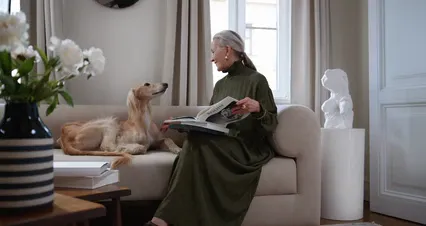
Effective strategies can greatly enhance the quality of life for senior dogs. Guide to choosing the right dog food for senior dogs
Understanding canine cognitive dysfunction is crucial. It’s not just a phase; it’s a medical condition that requires your attention. While there’s no magic pill to cure it, several strategies can help manage symptoms and improve your dog’s quality of life. With a little patience, love, and the right approach, you can help your furry companion navigate the twilight years with dignity and joy.
So, get ready to learn about the signs of CCD, the importance of veterinary support, and the various strategies to enhance your senior dog’s quality of life. Together, we can ensure your furry friend continues to thrive, even in their golden years. Let’s embark on this enlightening adventure to make sure your pup has the best life possible!
Understanding Canine Cognitive Dysfunction (CCD)
What is Canine Cognitive Dysfunction?
Canine Cognitive Dysfunction (CCD) is a progressive brain condition in senior dogs, similar to Alzheimer’s disease in humans. As dogs age, their brains undergo changes, leading to cognitive decline. This can result in behavioral changes, confusion, and memory issues. Imagine your once-enthusiastic pup now staring blankly at the wall or getting lost in their own backyard. This isn’t just old age; it’s CCD. Symptoms arise from neurodegenerative changes, including the buildup of amyloid plaques in the brain, which disrupt normal functioning. As heart-wrenching as it sounds, recognizing this syndrome early can significantly help in managing your dog’s quality of life.
Prevalence and Risk Factors
CCD is more common than many realize. Studies suggest that about 14% of dogs over eight years old experience some form of cognitive dysfunction. This percentage skyrockets to 68% in dogs aged 15-16 years. So, if your dog has hit the senior milestone, keep an eye out! Age is a primary risk factor, but certain breeds and genetics can also play a role. For instance, smaller breeds may show symptoms later than larger ones. Additionally, factors like nutrition and previous health issues can increase the likelihood of developing cognitive dysfunction. It’s a complex puzzle, and every piece matters.
Recognizing Symptoms
Recognizing the early signs of CCD is crucial. The DISHAA acronym helps pet owners identify cognitive decline: Disorientation, Interactions with others, Sleep-wake alterations, House soiling, Activity level changes, and Anxiety. Disorientation might look like your dog wandering aimlessly or forgetting familiar faces. Changes in social interactions can manifest as withdrawal or clinginess. Is your dog sleeping more during the day? That could indicate a shift in sleep patterns.
House soiling in previously trained dogs is another red flag. Additionally, watch for decreased activity or increased anxiety. Dogs may bark excessively or seem unsettled. Early detection is key in managing CCD, so be vigilant! Keeping a close watch over these symptoms can help ensure your furry friend receives the support they need during their golden years.
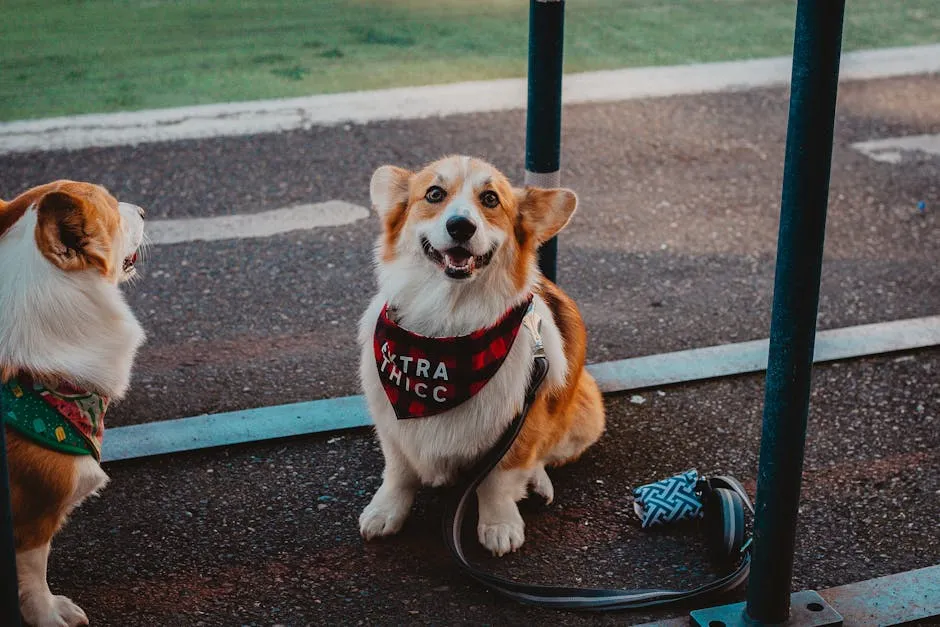
Diagnosis and Veterinary Support
Importance of Veterinary Diagnosis
If you suspect your dog is showing signs of CCD, seeking veterinary help is essential. Diagnosing CCD is often a process of elimination. Veterinarians will perform a thorough examination, considering medical history, behavioral changes, and may conduct tests to rule out other conditions, such as thyroid problems or neurological disorders. Because these symptoms can mimic other illnesses, accurate diagnosis is critical. Regular checkups for senior dogs can help catch these issues early. Remember, early detection means better management and a happier, healthier dog.
Tools and Assessment
Veterinary specialists utilize various tools to assess cognitive function. The Canine Cognitive Dysfunction Rating (CCDR) and the Canine Dementia Scale (CADES) are popular assessments. These tools help gauge the severity of cognitive decline and track changes over time. Moreover, monitoring your dog’s behavior at home can provide valuable insights. By combining your observations with veterinary assessments, you can develop a comprehensive plan to support your senior dog’s cognitive health. A proactive approach ensures your furry friend receives the care they need to thrive.
One of the best ways to support your dog’s cognitive health is through proper nutrition. Consider adding Hill’s Prescription Diet b/d Canine Dry Dog Food to your dog’s diet. This food is specifically formulated to support brain health and cognitive function in aging dogs. A well-balanced diet can make a significant difference!

Medication and Supplements
For some dogs, medication may be necessary to manage cognitive dysfunction. Selegiline, for example, is an FDA-approved drug that can enhance cognitive function in dogs with CCD. It’s essential to work closely with your veterinarian to determine if medication is the right choice for your pup.
In addition to prescribed medications, various supplements can support cognitive health. Phosphatidylserine and Apoaequorin are popular options that may enhance memory and learning. Discuss these with your vet to see which ones align best with your dog’s needs.

By implementing these strategies, you can significantly enhance your senior dog’s quality of life. With a little creativity and dedication, you can help your beloved pet navigate their twilight years with comfort and joy. Remember, your love and attention are the most powerful tools in this journey!
Enhancing Quality of Life
Environmental Adjustments
Creating a safe and familiar environment is key to minimizing disorientation for dogs with cognitive issues. Start by decluttering your home. A tidy space helps your pup navigate without getting confused or lost. Good lighting is another must-have! Ensure areas where your dog spends time are well-lit. This simple change can make a world of difference for their confidence.
Household modifications can further enhance safety. Consider installing ramps for easy access to furniture or vehicles. Non-slip mats can also prevent slips and falls, especially on hardwood floors. These adjustments make your home a haven for your senior dog, allowing them to move around comfortably and safely.

Dietary Considerations
Nutrition plays a vital role in managing cognitive decline in senior dogs. A well-balanced diet can help keep your pup’s brain sharp. Look for foods rich in antioxidants, omega-3 fatty acids, and vitamins. Hill’s Prescription Diet b/d is one such option, specifically designed to support brain health in aging dogs.
Supplements can also be beneficial. Omega-3 fatty acids and S-Adenosyl-L-methionine (SAMe) have shown promise in improving cognitive function. Always consult your vet before introducing new foods or supplements into your dog’s diet. They’ll help you create a plan that addresses your dog’s unique needs, ensuring they enjoy their meals while supporting their brain health.

Mental Stimulation and Enrichment Activities
Engaging your dog’s mind is just as important as physical care. Regular mental stimulation can slow cognitive decline and keep your dog happy. Consider interactive toys or puzzle feeders that challenge their problem-solving skills. The Outward Hound Hide-A-Squirrel Puzzle Toy can provide hours of excitement and engagement for your furry friend, keeping their mind sharp and active.
Maintain a consistent routine to provide a sense of security. Dogs thrive on predictability, so try to keep feeding, walking, and playtime at the same times each day. This routine not only helps reduce anxiety but also encourages your dog to engage more actively in their daily activities.
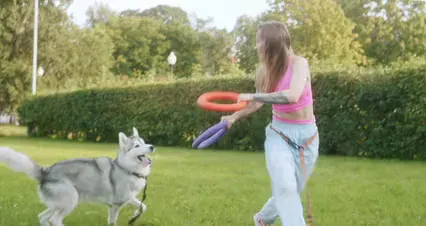
Medication and Supplements
For some dogs, medication may be necessary to manage cognitive dysfunction. Selegiline, for example, is an FDA-approved drug that can enhance cognitive function in dogs with CCD. It’s essential to work closely with your veterinarian to determine if medication is the right choice for your pup.
In addition to prescribed medications, various supplements can support cognitive health. Phosphatidylserine and Apoaequorin are popular options that may enhance memory and learning. Discuss these with your vet to see which ones align best with your dog’s needs.
By implementing these strategies, you can significantly enhance your senior dog’s quality of life. With a little creativity and dedication, you can help your beloved pet navigate their twilight years with comfort and joy. Remember, your love and attention are the most powerful tools in this journey!
Coping with Emotional Changes
Understanding Emotional Impact
Caring for a senior dog with cognitive issues can be an emotional rollercoaster. Owners often feel sadness, frustration, and helplessness as they witness the changes in their beloved companions. Dogs may exhibit anxiety, confusion, or changes in personality, which can be distressing. It’s essential to remember that patience is key. Showing empathy towards your dog’s condition fosters a supportive environment.
Understand that your dog senses your emotions. If you remain calm and supportive, your furry friend will feel more secure. Share your feelings with understanding friends or family; they can provide comfort during tough times.
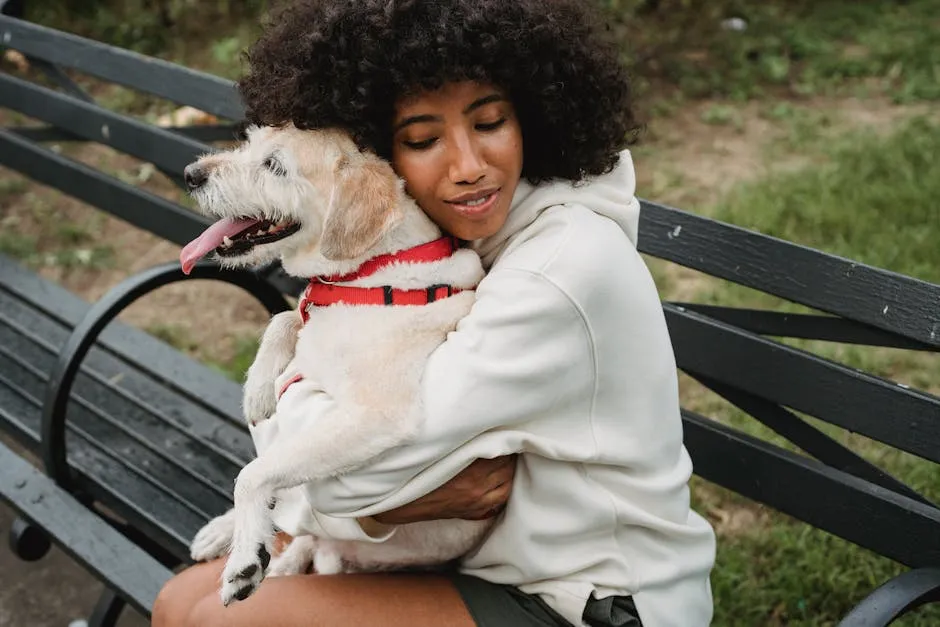
Self-Care for Owners
As a caregiver, don’t forget about your own well-being. Managing stress is vital for both you and your dog. Consider setting aside time for self-care. Engage in activities that relax you, whether it’s reading, exercising, or simply enjoying a warm cup of coffee.
Building a support network can also help. Connect with other pet owners facing similar challenges. Online forums or local groups can provide a space to share experiences and advice. Remember, you’re not alone in this journey. Taking care of yourself is essential to provide the best care for your senior dog. By maintaining your emotional health, you enhance your ability to support your furry friend through their twilight years.

FAQs
What is the difference between normal aging and CCD in dogs?
Normal aging in dogs involves gradual physical decline, like slower movements or less energy. Canine cognitive dysfunction (CCD), however, refers to specific neurodegenerative changes that lead to behavioral issues. CCD can cause confusion, disorientation, and altered social interactions, which are not typical in normal aging. Regular veterinary check-ups can help differentiate between the two.
How can I tell if my dog is experiencing anxiety due to cognitive dysfunction?
Signs of anxiety in dogs with cognitive dysfunction may include excessive barking, pacing, restlessness, or clinginess. They may also show increased fear of new stimuli or changes in routine. If you notice these behaviors alongside other cognitive decline symptoms, consult your vet for guidance on managing your dog’s anxiety.
Are there specific breeds that are more prone to CCD?
While all dogs can develop CCD, certain breeds may be more predisposed to cognitive dysfunction. Smaller breeds often show symptoms later in life, while larger breeds may develop issues earlier. It’s essential to monitor your dog’s behavior as they age, regardless of their breed.
What should I do if my dog exhibits severe behavioral changes?
If your dog suddenly displays severe behavioral changes, consult your veterinarian immediately. These changes could indicate worsening cognitive dysfunction or other health issues. A thorough examination can help rule out underlying medical conditions and provide recommendations for managing their behavior.
How can I ensure my dog feels secure and comfortable at home?
To create a secure environment for your dog, maintain a consistent routine, minimize clutter, and provide adequate lighting. Consider using non-slip mats to prevent slips and falls. Create a cozy resting area where your dog can retreat when feeling overwhelmed. These small adjustments can help reduce anxiety and promote comfort.
When should I seek veterinary assistance for my senior dog?
It’s advisable to seek veterinary assistance if you notice any signs of cognitive decline, such as disorientation, changes in behavior, or house-soiling issues. Regular check-ups are also essential for senior dogs, as early detection can lead to more effective management of cognitive dysfunction and other age-related health concerns.
What are some signs that indicate my dog’s quality of life is diminishing?
Signs that your dog’s quality of life may be diminishing include persistent pain, lack of interest in activities they once enjoyed, difficulty walking or standing, and noticeable weight loss. If your dog seems unusually withdrawn, anxious, or has frequent accidents, these may also be indicators. Consult with your veterinarian to assess your dog’s overall well-being and discuss the best course of action.
Please let us know what you think about our content by leaving a comment down below!
Thank you for reading till here 🙂
And speaking of keeping your furry friend happy, consider grabbing some Zuke’s Mini Naturals Dog Treats. These delightful little bites are perfect for training or just showering your dog with love. After all, who doesn’t love a treat?
For fun and engaging playtime, the PetSafe Busy Buddy Bristle Bone Dog Toy is a fantastic choice. It keeps dogs occupied while promoting dental health—talk about a win-win!
All images from Pexels

